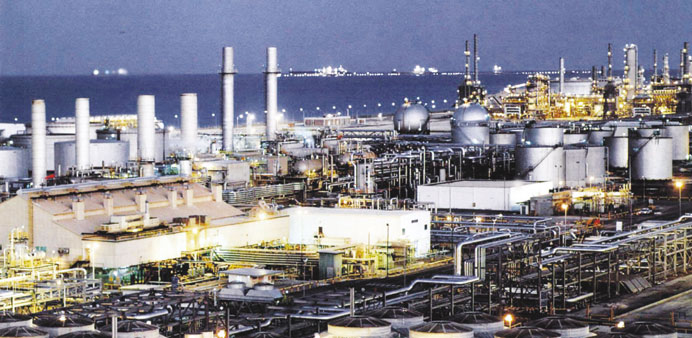An oil refinery on the east coast of Saudia Arabia. Oil traded $1.26 lower at $57.93 on the London-based ICE Futures Europe yesterday.
Bloomberg/New York
Standard Chartered’s Paul Horsnell forecasts oil will rise to $90 a barrel in the fourth quarter. Bank of America Merrill Lynch’s Francisco Blanch predicts $58. Six months ago, they were just $1 apart.
That sudden divergence highlights a growing trend: Energy analysts are the most divided in at least eight years on the direction of Brent crude, the global benchmark. Forecasters failed to predict the plunge that cut oil prices by more than half after the US shale boom boosted output to a three-decade high. Opec, led by Saudi Arabia, the world’s largest oil exporter, relinquished its traditional role adjusting production to moderate price swings in an effort to maintain market share.
This has left analysts split over how much and how quickly low prices will force US producers to shut, making their job “much messier,” according to Societe Generale SA. Horsnell said in a note on March 23 that output is falling faster than the consensus view, which will push prices higher. Blanch says the market remains oversupplied.
“What really changed the market was the Saudi decision to no longer balance supply to keep inventories steady,” Blanch, the top Brent forecaster in the fourth quarter according to data compiled by Bloomberg Rankings, said by phone on Thursday from New York. “The international market will be very well supplied even when the situation in the US changes.” Brent crude fell from last year’s high of $115.71 a barrel to a six-year low of $45.19 on January 13. Price swings were the widest since 2009, according to data compiled by Bloomberg. It traded $1.26 lower at $57.93 on the London-based ICE Futures Europe exchange by 5:05pm Singapore time yesterday.
The median view of 39 analysts is for Brent to average $69 in the fourth quarter, according to data compiled by Bloomberg. Horsnell’s $90 forecast, the highest projection, is 80% greater than the lowest, Andreas Speer of Bayerische Landesbank’s $50. That’s the biggest difference of views since the first quarter of 2007.
The Organisation of Petroleum Exporting Countries decided to keep production quotas unchanged at its November 28 meeting after US output surged 47% in five years to more than 9mn barrels a day.
“For better or worse, US shale is assuming that role now of swing supplier,” Mike Wittner, the fourth-highest ranked forecaster and head of oil research at Societe Generale in New York, who sees crude averaging $60 in the fourth quarter. “You have a couple of hundred small- to mid-sized companies doing the job” of Opec, he said by phone.
Oil’s plunge has prompted a 45% drop since December in the number of drilling rigs seeking oil in the US, the biggest slowdown on record. US shale oil output will post the slowest growth in more than four years in April, the Energy Information Administration said on March 9.
“We are in fairly uncharted territory,” said Eric Lee, an oil market strategist at Citigroup, which forecasts Brent rising to $65 in the fourth quarter. “We have shale supply. This was a massive new source of supply inserted into the cost curve. It’s really challenging Opec.” Standard Chartered’s Horsnell said on March 23 he expects US shale output to drop in the fourth quarter by an annual 65,000 barrels a day as a rise in uncompleted wells implies US oil output is falling faster than the consensus view.
A year ago, not a single analyst predicted oil’s tumble to below $50 a barrel in January. Brent has averaged $55 in the first quarter and the closest forecast a year ago was $85 by Capital Economics’ Tom Pugh.
Concern that the conflict in Yemen, where Saudi Arabia is leading air strikes against Shia rebels backed by Iran, will expand and hinder oil tankers leaving the Gulf, sent oil up as much as 5.8% on Thursday.

